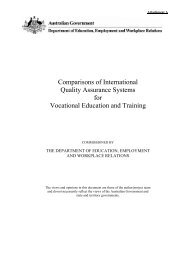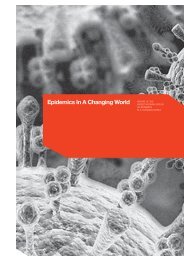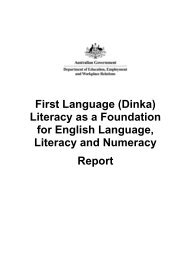National Survey of Research Commercialisation - Australian ...
National Survey of Research Commercialisation - Australian ...
National Survey of Research Commercialisation - Australian ...
Create successful ePaper yourself
Turn your PDF publications into a flip-book with our unique Google optimized e-Paper software.
The development, by St Pierre and his team at the University <strong>of</strong> Western Australia’s<br />
Faculty <strong>of</strong> Life and Physical Sciences, allows a doctor to more accurately measure<br />
iron concentrations in human tissue. Its main application is the management <strong>of</strong> iron<br />
metabolism disorders such as hereditary haemochromatosis and thalassaemia which can<br />
cause increased iron levels leading to tissue damage. Over time fibrosis and cirrhosis can<br />
set in, which can be fatal.<br />
PRODUCT SUCCESS STORIES<br />
Until now the only way a doctor has been able to measure the iron build up in the liver is<br />
by taking a core sample with a large millimetre-wide needle in a procedure considered so<br />
unpleasant that some patients refuse it.<br />
This sample is also <strong>of</strong>ten unreliable because the iron build-up is not uniform throughout<br />
the liver.<br />
However, the technology developed by the UWA team creates a liver map, showing<br />
accurately how much iron is in the liver and how it is distributed through the organ.<br />
There’s no patient discomfort, and the quality <strong>of</strong> information on which a doctor has to<br />
base his or her management <strong>of</strong> the disease is vastly improved.<br />
The development arose after St Pierre and his team realised the magnetic properties <strong>of</strong><br />
particles in tissue could produce information on their size and structure. He immediately<br />
started looking for practical ways to apply this discovery, especially for iron-overload<br />
diseases.<br />
An inter-disciplinary collaboration was formed — St Pierre, a medical chemist Dr Wanida<br />
Chua-Anusorn, and mature-age PhD student, Paul Clark, a specialist in electronics and<br />
electrical engineering who had previously been with the CSIRO Division <strong>of</strong> Radiophysics.<br />
The physicist, the chemist and the electronics engineer brought together just the right<br />
set <strong>of</strong> skills, with Clark able to write the sophisticated s<strong>of</strong>tware required to measure and<br />
interpret the iron concentrations.<br />
‘To make the measurements we had to understand the relationship between the physics<br />
<strong>of</strong> water molecules diffusing through iron-loaded tissue, and the general magnetic<br />
properties so we could work out how to drive a magnetic resonance imager to gather the<br />
data from which iron concentrations could be calculated,’ St Pierre explained.<br />
Once the team had the basic set-up it was tested on rats, then ‘phantoms’ (magnetic<br />
particles in a gel to simulate an iron-loaded liver) and finally in clinical trials with<br />
patients.<br />
A provisional patent was issued in 2000 and with a $400,000 equity investment by a Perth<br />
radiology provider, SKG Radiology, a spin-<strong>of</strong>f company, Inner Vision Biometrics was<br />
formed.<br />
Word-<strong>of</strong>-mouth saw the technology quickly picked up in New Zealand, Thailand (where<br />
there is a high incidence <strong>of</strong> thalassaemia), Indonesia, Portugal, Italy, Greece and the<br />
United States. However, in 2002, the NHMRC provided a grant to put the final touches on<br />
the research, and help the company to begin promoting the technology.<br />
57

















